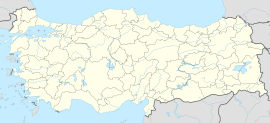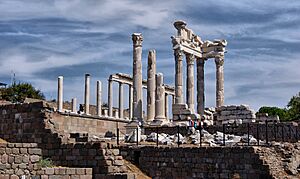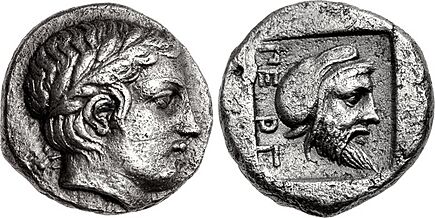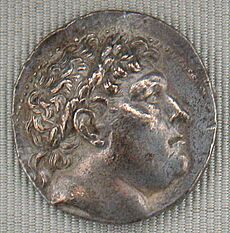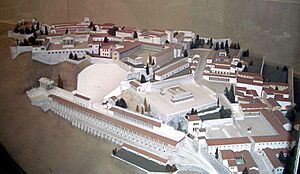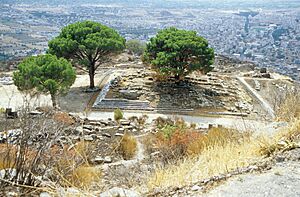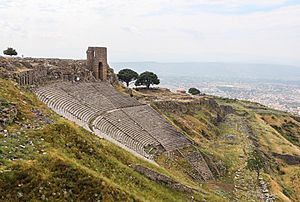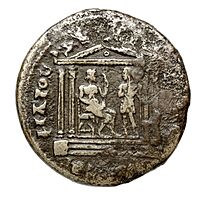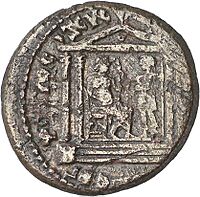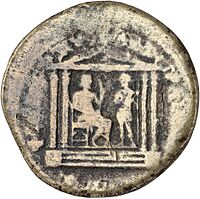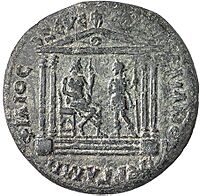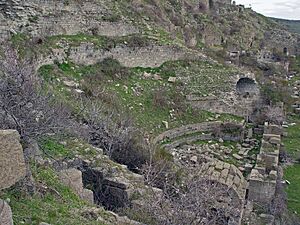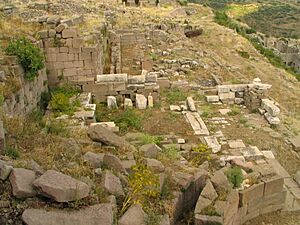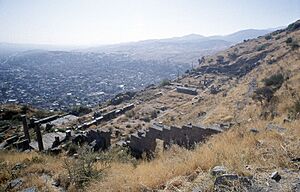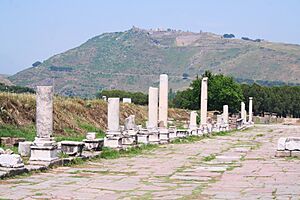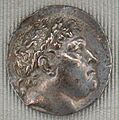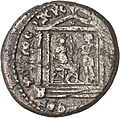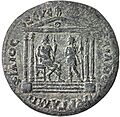Pergamon facts for kids
|
τὸ Πέργαμον
|
|
 |
|
| Alternative name | Pergamum |
|---|---|
| Location | Bergama, İzmir Province, Turkey |
| Region | Aeolis |
| Coordinates | 39°07′57″N 27°11′03″E / 39.13250°N 27.18417°E |
| Type | Settlement |
| Area | 90 ha (220 acres) |
| History | |
| Cultures | Greek |
| Associated with | Epigonus, Sosus of Pergamon, Aelius Nicon, Galen |
| Site notes | |
| Condition | Ruined |
| Ownership | Public |
| Public access | Yes |
| UNESCO World Heritage Site | |
| Official name | Pergamon and its Multi-Layered Cultural Landscape |
| Criteria | Cultural: i, ii, iii, iv, vi |
| Inscription | 2014 (38th Session) |
| Area | 332.5 ha |
| Buffer zone | 476.9 ha |
Pergamon (also called Pergamum) was a very rich and powerful ancient Greek city. It was located in a region called Aeolis. Today, you can find its ruins in Turkey, about 26 kilometres (16 mi) from the Aegean Sea. It sits on a hill near the modern city of Bergama.
During the Hellenistic period (a time after Alexander the Great), Pergamon became the capital of a kingdom. This was from 281 to 133 BC, under a family called the Attalids. They made Pergamon one of the most important cultural centers in the Greek world. Many parts of its old buildings can still be seen today. One famous masterpiece is the Pergamon Altar. Pergamon was also one of the seven churches of Asia mentioned in the New Testament Book of Revelation.
The city was built on a high, flat-topped hill, like a large table, about 335-metre-high (1,100 ft). This hill formed its acropolis (the highest part of an ancient Greek city). The sides of the hill are very steep, but there are three natural paths on the south side to reach the top. Two rivers, the Selinus and Cetius, flowed near the city.
In 2014, Pergamon was added to the UNESCO World Heritage List. This means it is a very important place for everyone to protect.
Contents
Where Was Pergamon Located?
Pergamon is in the northwest of Turkey, in a historical area called Mysia. It sits on the northern edge of the Caicus plain. The Caicus river flows through mountains and hills here. The city itself is on a large hill that rises 335 metres (1,099 ft) above sea level.
Even though it's only 26 kilometres (16 mi) from the sea, the area feels more like it's inland. In ancient times, the town of Elaia served as Pergamon's port. The weather in Pergamon is like other Mediterranean places, with dry summers from May to August.
The hill Pergamon is built on is made of volcanic rock. It is about one kilometer wide and 5.5 kilometres (3.4 mi) long from north to south. The top part, where the main city was, is quite narrow. The east side of the hill is a sharp cliff.
History of Pergamon
Early Times
People lived in Pergamon as far back as the Archaic period, around the late 8th century BC. We know this from small pieces of pottery found there. These pieces came from other Greek areas.
The first time Pergamon is mentioned in old writings is by Xenophon. He was a Greek soldier and writer. In 399 BC, his army ended their journey at Pergamon. At that time, Pergamon was ruled by a Greek family who were friendly with the Persian Empire.
Later, in 362 BC, a Persian governor named Orontes used Pergamon as a base. He tried to rebel against the Persian Empire but failed. Pergamon only became free from Persian control when Alexander the Great arrived.
Not many buildings from this early period remain. This is because later builders changed the land a lot. They built large terraces, which removed most of the older structures. However, parts of the Temple of Athena and the Sanctuary of Demeter date back to the 4th century BC.
The Hellenistic Kingdom
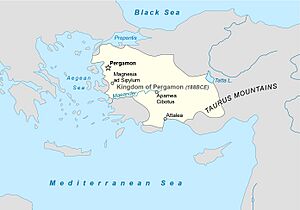

In 301 BC, Lysimachus, a king from Thrace, took control of Pergamon. His officer, Philetaerus, made the town bigger. In 281 BC, Lysimachus's kingdom fell apart. Philetaerus became an independent ruler. He started the Attalid dynasty, a ruling family.
The Attalid family ruled Pergamon from 281 to 133 BC. Philetaerus only controlled Pergamon and its nearby areas. But under Eumenes I, the city gained much more land. Even with more land, Eumenes did not call himself a king.
His successor, Attalus I, defeated the Galatians in 238 BC. The Galatians were a group to whom Pergamon had paid money. After this victory, Attalus declared himself king of an independent Pergamene kingdom.
The Attalids became strong allies of Rome. Attalus I helped Rome fight against Philip V of Macedon. Later, Pergamon joined Rome against Antiochus III. As a reward, Pergamon received almost all the land that Antiochus III had in Asia Minor. This made the kingdom very large.
Under the brothers Eumenes II and Attalus II, Pergamon became very grand. They wanted to make it a second Athens, a center for culture and art. They rebuilt their Acropolis to look like the one in Athens. The Library of Pergamon was famous, second only to the Library of Alexandria.
Pergamon was also known for making parchment. This is a material made from animal skin, used for writing. The word "parchment" comes from "pergamenos," meaning "from Pergamon." While parchment was used before Pergamon, the city became a major producer.
The Attalid brothers, Eumenes II and Attalus II, were known for their strong family bond. They had no rivalry, which was rare for ruling families back then. Attalus II was even called 'Philadelphos,' meaning 'he who loves his brother.'
When Attalus III died in 133 BC, he had no children. He left his entire kingdom to Rome. However, a man named Aristonicus claimed to be Attalus III's brother. He led an armed uprising against the Romans. He had some success at first, but was defeated in 129 BC.
The Attalid kingdom was then divided. Most of its land became a new Roman province called Asia. Pergamon itself was declared a free city. It briefly served as the capital of the province before Ephesus took that role.
Roman Times

In 88 BC, a king named Mithridates VI Eupator used Pergamon as his base. He fought against Rome but was defeated. After this, Rome took away Pergamon's special status as a free city. Pergamon had to pay taxes and provide for Roman soldiers.
Even so, Pergamon remained an important city. It was a center for regional meetings. The Roman Emperor Augustus gave the city the right to build a temple for the imperial cult. This was the first time this happened in the province of Asia. Important people from Pergamon continued to hold high positions in the Roman Empire.
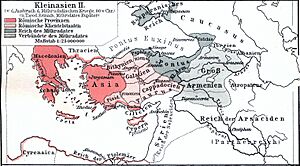
Under Emperor Trajan and later emperors, Pergamon was greatly rebuilt. A new Roman city was built at the base of the Acropolis. Trajan gave the city a second temple for the imperial cult. Emperor Hadrian made Pergamon a "metropolis" in 123 AD. This made it more important than rival cities like Ephesus and Smyrna.
Many new buildings were constructed. These included large temples, a stadium, a theater, a huge public square (forum), and an amphitheater. Also, a famous healing center for the god Asclepius was expanded. This place became one of the most well-known healing centers in the Roman world.
By the mid-2nd century AD, Pergamon was one of the largest cities in the province. It had about 200,000 people. Galen, a very famous doctor from ancient times, was born in Pergamon. He also trained at the Asclepieion.
However, the city started to decline in the 3rd century. It was badly damaged by an earthquake in 262 AD. Soon after, it was attacked by the Goths. In later Roman times, it recovered a little bit.
Byzantine Times
In 663/4 AD, Arab raiders captured Pergamon for the first time. Because of the ongoing Arab threat, people moved back to the acropolis. Emperor Constans II built a thick wall there using old stones to protect it.
Pergamon was part of the Byzantine Empire. In 716, it was attacked and looted again by Arab armies. But it was rebuilt and made stronger after the Arabs failed to capture Constantinople in 717–718.
The city suffered from Seljuk invasions after 1071. Attacks in 1109 and 1113 largely destroyed Pergamon. Emperor Manuel I Komnenos rebuilt it around 1170.
After Constantinople was sacked in 1204 during the Fourth Crusade, Pergamon became part of the Empire of Nicaea. When Emperor Theodore II Laskaris visited in 1250, he saw Galen's house. But he noted that the theater was destroyed and most other buildings were just ruins.
Around 1300, Pergamon was taken over by a Turkish group called the Karasids. Then, the Ottoman Turks conquered it. The Ottoman Sultan Murad III later took two large stone urns from Pergamon's ruins. He placed them in the Hagia Sophia in Istanbul.
Pergamon in Ancient Myths
Pergamon's founding story is linked to Telephus. He was the son of Heracles, a famous Greek hero. In myths, Telephus went to Mysia (where Pergamon is). He became the son-in-law or foster-son of the local king, Teuthras. Telephus then inherited the kingdom.
Telephus did not want to fight in the Trojan War. But his son, Eurypylus, fought for the Trojans. The people of Pergamon honored Telephus. They believed his mother, Auge, was buried near the Caicus river in Pergamon. This way, Pergamon became part of the famous Trojan epic stories.
Another myth connects the city's founding to Pergamus. He was the grandson of Achilles, another great Greek hero. Pergamus was said to have fled to Mysia with his mother. There, he killed the local ruler and named the city after himself. He also built a special shrine for his mother.
These myths helped the Attalid rulers of Pergamon. They wanted to show that their family was connected to famous heroes like Heracles and Achilles. This made their rule seem more important and special. The people of Pergamon even called themselves Telephidai, meaning 'children of Telephus.' They also called Pergamon the 'Telephian city.'
Discovering Ancient Pergamon
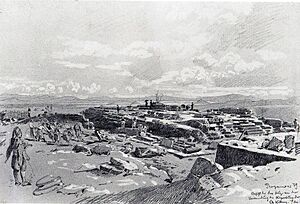
People started writing about Pergamon again in the 13th century. From the 15th century onwards, more travelers visited the site. They wrote about what they saw.
In the late 18th century, scholars became very interested in ancient sites. Carl Humann, a German engineer, first visited Pergamon in 1864. He became very interested in the city's ancient remains.
In 1871, Humann organized a small expedition. They found two pieces of a large frieze. These were sent to Berlin for study. Later, it was thought these pieces might be from the Great Altar of Pergamon.
Because of this, Carl Humann was given permission to start excavations in 1878. He worked near the Altar of Zeus until 1886. With the approval of the Ottoman Empire, the carved reliefs found there were sent to Berlin. The Pergamon Museum in Berlin was opened in 1907 to display them.
The work continued under other archaeologists. Wilhelm Dörpfeld led excavations from 1900 to 1911. He made important discoveries, like the Lower Agora and the Gymnasium.
Excavations stopped during the First World War. They started again in 1927 under Theodor Wiegand. He focused on the upper city, the Asclepieion, and the Red Basilica. The Second World War caused another break until 1957.
Since 2006, Felix Pirson has led the excavations. Most of the finds from before World War I are in the Pergamon Museum in Berlin. Some are in the İstanbul Archaeological Museum. After World War I, the Bergama Museum was opened. It now receives all new discoveries.
In May 2022, archaeologists found an 1,800-year-old floor mosaic near the Red Basilica. It has beautiful geometric patterns.
Main Sights of Pergamon
Upper Acropolis
The Pergamon Altar
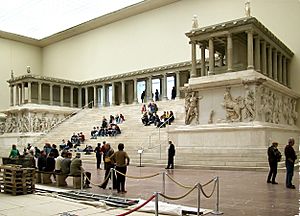
The most famous building from Pergamon is the huge altar. It is sometimes called the Great Altar. It was probably built for the gods Zeus and Athena. You can still see its foundations in the Upper City. However, the amazing carvings (frieze) that decorated it are in the Pergamon Museum in Berlin. Parts of the frieze have been put back together there.
The altar's base was about 36 by 33 meters. Its outside was decorated with a detailed carving called the Gigantomachy. This showed the battle between the Olympian gods and the Giants. This carving is 2.30 meters high and 113 meters long. It is the second longest ancient frieze known.
A wide staircase led up to the altar's top part. Inside, there was another carving. This one showed the life of Telephus, the mythical founder of Pergamon.
In the New Testament Book of Revelation, the author talks about the Pergamon believers living "where Satan's throne is." Many scholars think this "seat of Satan" refers to the Pergamon Altar. This is because it looked like a giant throne.
The Theater
The ancient theater in Pergamon is very well-preserved. It was built during the Hellenistic period. It could hold about 10,000 people in 78 rows of seats. At 36 meters high, it is one of the steepest ancient theaters in the world.
Below the theater, there is a long terrace. It is 247-metre-long (810 ft) and up to 17.4-metre-wide (57 ft). This terrace had a long covered walkway (stoa). In Greek theaters, there was usually a circular area for performers. But here, only a wooden stage was built. This stage could be taken down. This way, the view along the terrace to the Temple of Dionysus was clear. A marble stage was only built later, in the 1st century BC.
The Temple of Trajan (Traianeum)
At the very top of the Acropolis is the Temple of Trajan. It is also called the Temple of Zeus Philios. Both Zeus and Emperor Trajan were worshipped here. The temple sits on a high platform.
The temple itself was a Corinthian style temple. It had six columns on the short sides and nine on the long sides. During excavations, parts of statues of Trajan and Hadrian were found. Pieces of the cult statue of Zeus Philios were also discovered.
The Temple of Dionysus
In Pergamon, the god Dionysus was called 'Kathegemon,' meaning 'the guide.' He was an important god for the Attalid rulers. In the 2nd century BC, King Eumenes II likely built a temple for Dionysus. It was at the northern end of the theater terrace.
The marble temple sits on a platform, 4.5-metre-high (15 ft). It was an Ionic style temple. Most of what you see today comes from a reconstruction that happened later, probably under Emperor Caracalla.
The Temple of Athena
Pergamon's oldest temple is a sanctuary for Athena. It dates back to the 4th century BC. It was a Doric style temple with six columns on the short sides and ten on the long sides. Its foundations are still visible today.
Under King Eumenes II, a two-story covered walkway (stoa) was added around the temple. Also, a grand entrance (propylon) was built. This entrance is now largely rebuilt and displayed in the Pergamon Museum in Berlin.
The balustrade (railing) of the upper level of the stoas had carvings. These showed weapons and celebrated Eumenes II's military victories. The northern stoa is thought to have been the location of the famous Library of Pergamon.
The Library
The Library of Pergamum was the second largest in the ancient Greek world. Only the Library of Alexandria was bigger. It held at least 200,000 scrolls. The exact location of the library building is not completely certain. However, it is generally believed to have been an annex of the northern stoa of the Sanctuary of Athena.
Other Upper Acropolis Structures
Other important buildings still visible on the upper part of the Acropolis include:
- The Royal palaces, where the kings lived.
- The Heroön, a shrine where the kings were worshipped.
- The Upper Agora, a public meeting place.
- The Roman baths complex, for bathing and socializing.
- The Diodorus Pasporos heroon.
- The Arsenals, where weapons were stored.
Today, you can easily reach the Acropolis by the Bergama Acropolis Gondola.
Lower Acropolis
The Gymnasium
A large gymnasium was built in the 2nd century BC. It was on the south side of the Acropolis. It had three levels or terraces. The lowest terrace was for boys.
The middle terrace was about 250 meters long and 70 meters wide. It had a two-story hall on its north side. There was also a small temple. A covered stadium was located between the middle and upper terraces.
The upper terrace was the largest, measuring 150 by 70 meters. It had a courtyard surrounded by covered walkways (stoas). This area is thought to be a palaestra, a place for wrestling and exercise. It also had a lecture hall and a large banquet hall. In Roman times, a bath complex was added here.
The Sanctuary of Hera
The Sanctuary of Hera Basileia ('the Queen') was north of the gymnasium. It was built on two terraces. The Temple of Hera stood in the middle of the upper terrace. It faced south.
The temple was about 7 meters wide and 12 meters long. It was a Doric style temple. All other buildings in the sanctuary were made of local stone. But the temple itself was made of marble or covered in marble. Inside, the base of the cult statue held three statues.
An inscription on the temple shows it was dedicated to Hera Basileia. It was built by King Attalus II.
The Sanctuary of Demeter
The Sanctuary of Demeter was on the middle level of the citadel's south slope. It was an old sanctuary, used since the 4th century BC.
You entered the sanctuary through a grand gateway (Propylon) from the east. This led to a courtyard with covered walkways on three sides. In the center of the western half was the Ionic temple of Demeter. It was a simple temple, measuring 6.45 by 12.7 meters.
About 9.5 meters in front of the temple was an altar. The temple and altar were built for Demeter by Philetaerus, his brother Eumenes, and their mother Boa.
In the eastern part of the courtyard, there were more than ten rows of seats. These were for people taking part in the mysteries of Demeter. About 800 people could sit there.
Other Lower Acropolis Structures
The lower part of the Acropolis also includes:
- The House of Attalus.
- The Lower Agora, another public square.
- The Gate of Eumenes, a monumental city gate.
At the Foot of the Acropolis
The Sanctuary of Asclepius (Asclepieion)
About three kilometres (1.9 miles) south of the Acropolis, in the valley, is the Sanctuary of Asclepius. He was the god of healing. This sanctuary, also called the Asclepieion, was reached by a long, 820-metre (2,690 ft) colonnaded sacred road.
People with health problems would come here to bathe in the water from the sacred spring. They believed Asclepius would appear in their dreams and tell them how to get better. Archaeologists have found many small terracotta body parts left as gifts. These probably represented the parts of the body that were healed. Galen, a very famous doctor in the ancient Roman Empire, worked at the Asclepieion for many years.
Important buildings in the Asclepieion include:
- The Roman theater.
- The North and South Stoas (covered walkways).
- The Temple of Asclepius, sometimes called the Temple of Zeus Asclepius Soter (meaning "savior").
- A round building used for treatments.
- A healing spring.
- An underground passageway.
- A library.
- The Via Tecta (or Sacred Way), the road leading to the sanctuary.
- A propylon (grand entrance).
The Serapis Temple (Red Basilica)
Another important building in Pergamon is the large temple of the Egyptian gods Isis and/or Serapis. Today, it is known as the Red Basilica (or Kızıl Avlu in Turkish). It is about one kilometre (0.62 miles) south of the Acropolis.
This temple has a main building and two round towers. These are inside a huge sacred area. The temple towers had courtyards with pools for washing. The front courtyard of the temple is still supported by the 193-metre-wide (633-foot) Pergamon Bridge. This is the largest bridge foundation from ancient times.
According to Christian tradition, in 92 AD, Saint Antipas was the first bishop of Pergamum. He was killed here by angry people who worshipped Serapis. They are said to have burned him alive in front of the temple. This event is mentioned in the New Testament Book of Revelation.
City Planning and Homes
Pergamon is a great example of a city that grew in a planned way.
The first ruler, Philetairos, made Pergamon a fortified city. He built a wall around the upper city. This included the plateau to the south, the upper agora, and some houses.
Under Kings Eumenes II and Attalos II, the city expanded a lot. A new street system was created. A new city wall, with a grand gate called the Gate of Eumenes, was built south of the Acropolis. This wall now surrounded the entire hill. Many public buildings were constructed, including new marketplaces and a new gymnasium.
The layout of Pergamon was affected by the very steep hill. Streets had to turn sharply to climb the hill easily. Building houses and public squares also required a lot of work to create flat terraces.
In Roman times, a completely new city was built west of the Selinus river. It had all the necessary buildings like baths, theaters, and temples. This Roman new city did not need city walls because there were no outside threats.
Homes in Pergamon
Most Hellenistic houses in Pergamon had a small, square courtyard in the middle. Rooms were built on one or two sides of this courtyard. The main rooms were often on the north side, sometimes on two levels.
Because of the hilly land, houses were not always perfectly aligned north-south. Their size and layout varied. Many houses had cisterns in their courtyards. These collected rainwater from the roofs.
Public Spaces
From the start of Philetairos's rule, public events happened on the Acropolis. The 'Upper Agora' was developed here. Under King Attalos I, a Temple of Zeus was built there. This Upper Agora became a center for trade and public shows.
The 'Lower Agora' was built under Eumenes II. It was 80 meters long and 55 meters wide. Like the Upper Agora, its shape fit the steep land. It had three levels. The market area spread over two levels, with a large hall in the center. This hall had small shops.
Streets and Bridges
The main street of Pergamon winds up the hill to the Acropolis with sharp turns. This is typical of the city's street system. Shops and warehouses lined this street. The street surface was made of large stone blocks. It also had a drainage system to carry water down the slope.
Under Eumenes II, the city plan became more organized. A fan-shaped design was used for the area around the gymnasium. Streets were up to four meters wide to help traffic flow.
The nearly 200-meter-wide Pergamon Bridge is under the forecourt of the Red Basilica. It is the largest bridge foundation from ancient times.
Water Supply
Pergamon had a very good water supply system. Besides cisterns, there was a system of nine pipes. Seven were Hellenistic ceramic pipes, and two were open Roman channels. This system provided about 30,000–35,000 cubic meters of water per day.
The Madradağ aqueduct brought water to the citadel from over 40 kilometers away. This was in the Hellenistic period. The water traveled through a pipe that crossed a 200-metre-deep (660 ft) valley. It used pressure to bring water up to the height of the citadel.
Important People from Pergamon
- Epigonus (3rd century BC), a Greek sculptor.
- Sosus of Pergamon (2nd century BC), a Greek artist who made mosaics.
- Apollodorus (1st century BC), a teacher of the Roman Emperor Augustus.
- Antipas of Pergamum (1st century AD), an early Christian martyr and saint.
- Aelius Nicon (2nd century AD), a Greek architect.
- Galen (c. 129–200/216 AD), a very famous Greek doctor.
- Oribasius (c. 320-403 AD), a Greek doctor.
Images for kids
-
Possible coinage of the Greek ruler Gongylos, wearing the Persian cap on the reverse, as ruler of Pergamon for the Achaemenid Empire. Pergamon, Mysia, circa 450 BC. The name of the city ΠΕΡΓ ("PERG"), appears for the first on this coinage, and is the first evidence for the name of the city.
-
The Kingdom of Pergamon, shown at its greatest extent in 188 BC
-
Over-life-size portrait head, probably of Attalus I
-
Mithridates VI, portrait in the Louvre
-
Pergamon in the Roman province of Asia, 90 BC
-
Christian Wilberg: Excavation area of the Pergamon Altar. 1879 sketch.
-
The Great Altar of Pergamon, on display in the Pergamon Museum in Berlin, Germany


